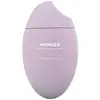What's inside
What's inside
 Key Ingredients
Key Ingredients

 Benefits
Benefits

 Concerns
Concerns

 Ingredients Side-by-side
Ingredients Side-by-side

Water
Skin ConditioningPropanediol
SolventCetearyl Olivate
Sorbitan Olivate
EmulsifyingGlycerin
HumectantCarthamus Tinctorius Seed Oil
MaskingPolyglyceryl-3 Stearate
EmulsifyingCetearyl Alcohol
EmollientOryza Sativa Extract
AbsorbentHeptyl Undecylenate
EmollientCaprylic/Capric Triglyceride
MaskingOenothera Biennis Oil
EmollientPhyllostachys Pubescens Shoot Bark Extract
Skin ConditioningAspergillus Ferment
Skin ConditioningPanax Ginseng Root Extract
EmollientCyclodextrin
AbsorbentHyaluronic Acid
HumectantPulsatilla Koreana Extract
Skin ConditioningZanthoxylum Piperitum Fruit Extract
Skin ConditioningUsnea Barbata Extract
Cetyl Palmitate
EmollientSodium Phytate
Sorbitan Palmitate
Emulsifying1,2-Hexanediol
Skin ConditioningAlcohol
AntimicrobialButylene Glycol
HumectantLavandula Angustifolia Oil
MaskingWater, Propanediol, Cetearyl Olivate, Sorbitan Olivate, Glycerin, Carthamus Tinctorius Seed Oil, Polyglyceryl-3 Stearate, Cetearyl Alcohol, Oryza Sativa Extract, Heptyl Undecylenate, Caprylic/Capric Triglyceride, Oenothera Biennis Oil, Phyllostachys Pubescens Shoot Bark Extract, Aspergillus Ferment, Panax Ginseng Root Extract, Cyclodextrin, Hyaluronic Acid, Pulsatilla Koreana Extract, Zanthoxylum Piperitum Fruit Extract, Usnea Barbata Extract, Cetyl Palmitate, Sodium Phytate, Sorbitan Palmitate, 1,2-Hexanediol, Alcohol, Butylene Glycol, Lavandula Angustifolia Oil
Water
Skin ConditioningPropanediol
SolventGlycerin
Humectant1,2-Hexanediol
Skin ConditioningCyclopentasiloxane
EmollientCyclohexasiloxane
EmollientSclerotium Gum
Emulsion StabilisingBetaine
HumectantHyaluronic Acid
HumectantCarbomer
Emulsion StabilisingXanthan Gum
EmulsifyingTocopherol
AntioxidantTromethamine
BufferingCamellia Sinensis Leaf Extract
AntimicrobialSaccharomyces Ferment
Skin ConditioningLactobacillus Ferment
Skin ConditioningHoney
HumectantCaprylyl Glycol
EmollientBenzyl Salicylate
PerfumingCitral
PerfumingEthyl Linalool
MaskingTetramethyl Acetyloctahydronaphthalenes
MaskingMethyldihydrojasmonate
MaskingDisodium EDTA
Cetyl Ethylhexanoate
EmollientCI 61565
Cosmetic ColorantWater, Propanediol, Glycerin, 1,2-Hexanediol, Cyclopentasiloxane, Cyclohexasiloxane, Sclerotium Gum, Betaine, Hyaluronic Acid, Carbomer, Xanthan Gum, Tocopherol, Tromethamine, Camellia Sinensis Leaf Extract, Saccharomyces Ferment, Lactobacillus Ferment, Honey, Caprylyl Glycol, Benzyl Salicylate, Citral, Ethyl Linalool, Tetramethyl Acetyloctahydronaphthalenes, Methyldihydrojasmonate, Disodium EDTA, Cetyl Ethylhexanoate, CI 61565
 Reviews
Reviews

Ingredients Explained
These ingredients are found in both products.
Ingredients higher up in an ingredient list are typically present in a larger amount.
1,2-Hexanediol is a synthetic liquid and another multi-functional powerhouse.
It is a:
- Humectant, drawing moisture into the skin
- Emollient, helping to soften skin
- Solvent, dispersing and stabilizing formulas
- Preservative booster, enhancing the antimicrobial activity of other preservatives
Glycerin is already naturally found in your skin. It helps moisturize and protect your skin.
A study from 2016 found glycerin to be more effective as a humectant than AHAs and hyaluronic acid.
As a humectant, it helps the skin stay hydrated by pulling moisture to your skin. The low molecular weight of glycerin allows it to pull moisture into the deeper layers of your skin.
Hydrated skin improves your skin barrier; Your skin barrier helps protect against irritants and bacteria.
Glycerin has also been found to have antimicrobial and antiviral properties. Due to these properties, glycerin is often used in wound and burn treatments.
In cosmetics, glycerin is usually derived from plants such as soybean or palm. However, it can also be sourced from animals, such as tallow or animal fat.
This ingredient is organic, colorless, odorless, and non-toxic.
Glycerin is the name for this ingredient in American English. British English uses Glycerol/Glycerine.
Learn more about GlycerinHyaluronic acid is naturally found in healthy skin. It is a humectant, meaning it draws moisture to your skin.
This ingredient helps hydrate, soothe, and protect the skin.
What makes hyaluronic acid so hydrating? It has the capacity to bind or hold large amounts of water.
Fun fact: It is already naturally found in our bodies, such as the fluids of our eyes and our joints.
Studies find this ingredient to have anti-inflammatory and anti-microbial properties. This can help speed up wound-healing.
Hyaluronic acid can be irritating if the molecule has a low-molecular weight, or if the molecules are small.
One study found low-molecular weight hyaluronic acid to be pro-inflammatory, meaning some people may experience irritation. This is because our bodies use hyaluronic acid in the wound-healing process to signal to our bodies, via irritation, that something needs healing.
The same study found high-molecular weight hyaluronic acid to be anti-inflammatory.
These are some other common types of Hyaluronic Acid:
Learn more about Hyaluronic AcidPropanediol is an all-star ingredient. It softens, hydrates, and smooths the skin.
It’s often used to:
Propanediol is not likely to cause sensitivity and considered safe to use. It is derived from corn or petroleum with a clear color and no scent.
Learn more about PropanediolWater. It's the most common cosmetic ingredient of all. You'll usually see it at the top of ingredient lists, meaning that it makes up the largest part of the product.
So why is it so popular? Water most often acts as a solvent - this means that it helps dissolve other ingredients into the formulation.
You'll also recognize water as that liquid we all need to stay alive. If you see this, drink a glass of water. Stay hydrated!
Learn more about Water